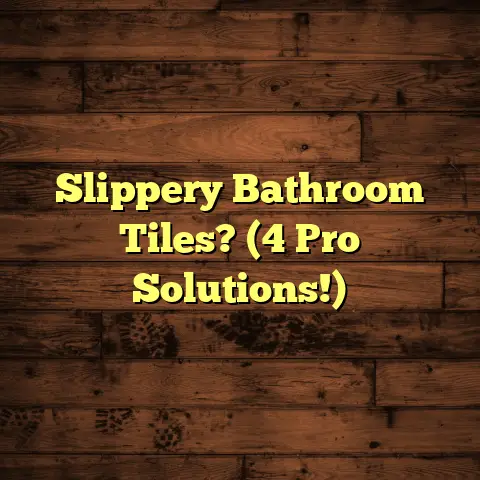Plastic Over Wood Floors? (2 Big Mistakes!)
Ever wonder how the weather outside impacts what’s under your feet?
I’m talking about your floors!
As a flooring contractor for over 15 years, I’ve seen it all – the good, the bad, and the downright disastrous.
And let me tell you, Mother Nature can be a real flooring foe if you’re not careful.
Think about it: blistering summer heat, freezing winter temps, and humidity that makes your hair stand on end!
All of these things can wreak havoc on your flooring, especially when you’re thinking about laying plastic over wood.
I’ve seen beautiful hardwood floors buckle and warp from too much moisture, and I’ve also seen plastic flooring bubble and peel from extreme temperature swings.
It’s not a pretty sight, and it’s definitely something you want to avoid.
That’s why I’m writing this article – to help you understand the potential pitfalls of putting plastic over wood floors, and how to avoid making some common (and costly) mistakes.
Understanding Wood Floors
Let’s start with the basics: wood flooring.
We’re talking about those gorgeous planks made from solid wood, like oak, maple, cherry, or even exotic species like Brazilian walnut.
These floors aren’t just beautiful; they’re also durable and can add serious value to your home.
Think about the timeless elegance of a classic oak floor or the warm, inviting feel of a cherry wood.
They’re a real selling point!
But here’s the thing: wood is a natural material, which means it’s susceptible to environmental changes.
Specifically, moisture and temperature.
Wood is like a sponge; it absorbs moisture from the air, causing it to expand.
Conversely, in dry conditions, it loses moisture and shrinks.
These constant fluctuations can lead to problems like warping, cupping (where the edges of the planks rise), and even cracking.
I’ve seen floors that look like roller coasters because of moisture issues!
It’s crucial to understand these vulnerabilities before you even think about covering your wood floors with anything, especially plastic.
Introducing Plastic Flooring
Now, let’s talk about plastic flooring.
This is a broad category that includes vinyl planks, laminate, and other synthetic materials designed to mimic the look of real wood, tile, or stone.
Plastic flooring has become incredibly popular in recent years, and for good reason.
It’s generally more affordable than real wood, easier to install (DIY-friendly!), and often more resistant to moisture.
Think about a busy household with kids and pets – plastic flooring can be a real lifesaver when it comes to spills and scratches.
However, plastic flooring isn’t without its downsides.
For starters, it doesn’t have the same aesthetic appeal as natural wood.
While manufacturers have gotten much better at creating realistic-looking textures and patterns, it’s still not quite the same as the real deal.
Also, there are environmental concerns associated with plastic production and disposal.
Many types of plastic flooring are not biodegradable and can contribute to landfill waste.
Plus, the manufacturing process can release harmful chemicals into the environment.
So, while plastic flooring can be a practical choice, it’s important to weigh the pros and cons carefully.
Mistake #1 – Ignoring Moisture and Temperature Control
Okay, now we’re getting to the heart of the matter.
Why is putting plastic over wood such a risky proposition?
The biggest mistake I see homeowners make is ignoring the importance of moisture and temperature control.
Remember how I said wood expands and contracts with changes in humidity and temperature?
Well, plastic flooring doesn’t do that – at least, not to the same extent.
When you lay plastic over wood, you’re essentially trapping the wood underneath.
This can create a perfect breeding ground for moisture, especially if there’s any existing dampness in the subfloor or if the room isn’t properly ventilated.
And what happens when you have moisture trapped under plastic?
You guessed it: mold and mildew.
These nasty fungi can not only damage the wood itself, causing it to rot and decay, but they can also release harmful spores into the air, leading to health problems for you and your family.
I’ve been called to homes where the subfloor was literally covered in mold because the homeowner had installed plastic flooring without a proper moisture barrier.
The smell was awful, and the cleanup was expensive and time-consuming.
But the damage doesn’t stop there.
The trapped moisture can also cause the wood to warp and buckle, even if it’s covered by plastic.
This can lead to unevenness in the flooring, cracks in the plastic, and an overall unattractive appearance.
I remember one case where a homeowner laid vinyl flooring over a beautiful hardwood floor in their basement.
They thought they were protecting the hardwood from moisture, but they actually created a moisture sandwich!
Within a few months, the vinyl started to bubble and peel, and when I pulled it up, the hardwood underneath was completely rotted.
The cost to repair the damage was thousands of dollars, and the homeowner deeply regretted their decision.
Pro Tip: Before installing any type of flooring, especially plastic over wood, always test the moisture levels in the subfloor.
You can use a simple moisture meter, available at most hardware stores, to get an accurate reading.
According to the National Wood Flooring Association (NWFA), the moisture content of the subfloor should be within 2-4% of the moisture content of the wood flooring you plan to install.
If the moisture levels are too high, you’ll need to take steps to dry out the subfloor before proceeding.
This might involve using a dehumidifier, improving ventilation, or even addressing underlying plumbing leaks.
Mistake #2 – Overlooking Proper Installation Techniques
Okay, let’s say you’ve addressed the moisture issue.
You’ve tested the subfloor, made sure it’s dry, and you’re ready to install your plastic flooring.
Great! But don’t get ahead of yourself.
The second big mistake I see homeowners make is overlooking the importance of proper installation techniques.
Even if you’re a seasoned DIYer, installing plastic flooring over wood requires careful attention to detail.
One of the most common mistakes is failing to use an underlayment.
An underlayment is a thin layer of material that goes between the subfloor and the plastic flooring.
It provides a number of benefits, including:
- Moisture barrier: Helps to prevent moisture from seeping up from the subfloor.
- Sound insulation: Reduces noise transmission between floors.
- Cushioning: Provides a more comfortable surface to walk on.
- Smoothing: Helps to even out minor imperfections in the subfloor.
Without an underlayment, you’re essentially laying the plastic flooring directly on the wood, which can amplify any existing moisture problems and create an uneven surface.
Another common mistake is not allowing for expansion gaps.
Remember how wood expands and contracts?
Well, plastic flooring does too, although to a lesser extent.
When you install plastic flooring, you need to leave a small gap (usually about 1/4 inch) around the perimeter of the room to allow for expansion and contraction.
If you don’t leave these gaps, the flooring can buckle and warp as it expands, creating an unsightly and potentially dangerous situation.
I once had to rip up an entire vinyl floor because the homeowner had installed it tight against the walls, without leaving any expansion gaps.
The flooring had buckled so badly that it was impossible to walk on without tripping.
Finally, improper adhesive use can also lead to problems.
Some types of plastic flooring require adhesive to be applied to the subfloor before installation.
It’s crucial to use the correct type of adhesive, and to apply it according to the manufacturer’s instructions.
Using the wrong adhesive can cause the flooring to peel up, bubble, or even damage the wood underneath.
I’ve seen cases where homeowners used construction adhesive instead of flooring adhesive, resulting in a gummy, sticky mess that was impossible to clean up.
Pro Tip: Always read and follow the manufacturer’s instructions carefully when installing plastic flooring.
If you’re not comfortable with any aspect of the installation process, it’s always best to hire a professional flooring contractor.
Yes, it will cost more upfront, but it can save you a lot of time, money, and headaches in the long run.
The Long-term Impact of These Mistakes
So, what happens if you ignore these two big mistakes – moisture management and installation techniques?
What are the long-term repercussions?
Well, let me tell you, they can be significant.
First, there are the financial implications.
Repairing or replacing damaged flooring can be expensive.
Depending on the extent of the damage, you might need to tear up the entire floor, replace the subfloor, and install new flooring.
This can easily cost thousands of dollars.
And if the damage is caused by mold or mildew, you might also need to hire a professional mold remediation company, which can add even more to the cost.
But the financial costs are just the tip of the iceberg.
There are also the emotional and aesthetic consequences to consider.
A damaged floor can be a real eyesore, making your home feel less comfortable and inviting.
It can also be a source of stress and anxiety, especially if you’re worried about the health risks associated with mold and mildew.
I’ve seen homeowners who were so frustrated with their flooring problems that they literally lost enjoyment in their living spaces.
They were constantly worried about the damage getting worse, and they were embarrassed to have guests over.
And let’s not forget about the potential impact on your property value.
A damaged floor can significantly reduce the value of your home, making it harder to sell if you ever decide to move.
According to a survey by the National Association of Realtors (NAR), 82% of homebuyers said that flooring was an important factor in their decision to purchase a home.
Damaged or outdated flooring can be a major turnoff for potential buyers, and they may be less willing to pay top dollar for your property.
Pro Tip: Regularly inspect your flooring for signs of damage, such as warping, buckling, cracking, or discoloration.
If you notice any problems, address them promptly to prevent them from getting worse.
Also, make sure to maintain proper ventilation in your home, especially in areas where moisture is a concern, such as basements and bathrooms.
Use dehumidifiers and exhaust fans to control humidity levels and prevent mold growth.
Conclusion
So, there you have it – the two big mistakes to avoid when considering plastic flooring over wood: ignoring moisture and temperature control, and overlooking proper installation techniques.
I know it can seem like a lot to think about, but trust me, taking the time to do it right is worth it in the long run.
By being mindful of weather conditions, understanding the properties of wood and plastic flooring, and following proper installation practices, you can prevent costly mistakes and enhance the longevity and beauty of your home’s flooring.
Remember, informed decisions are the key to success.
Don’t be afraid to ask questions, do your research, and seek professional advice when needed.
Your floors are a major investment, and they deserve the best possible care.
So, go forth and floor wisely!





